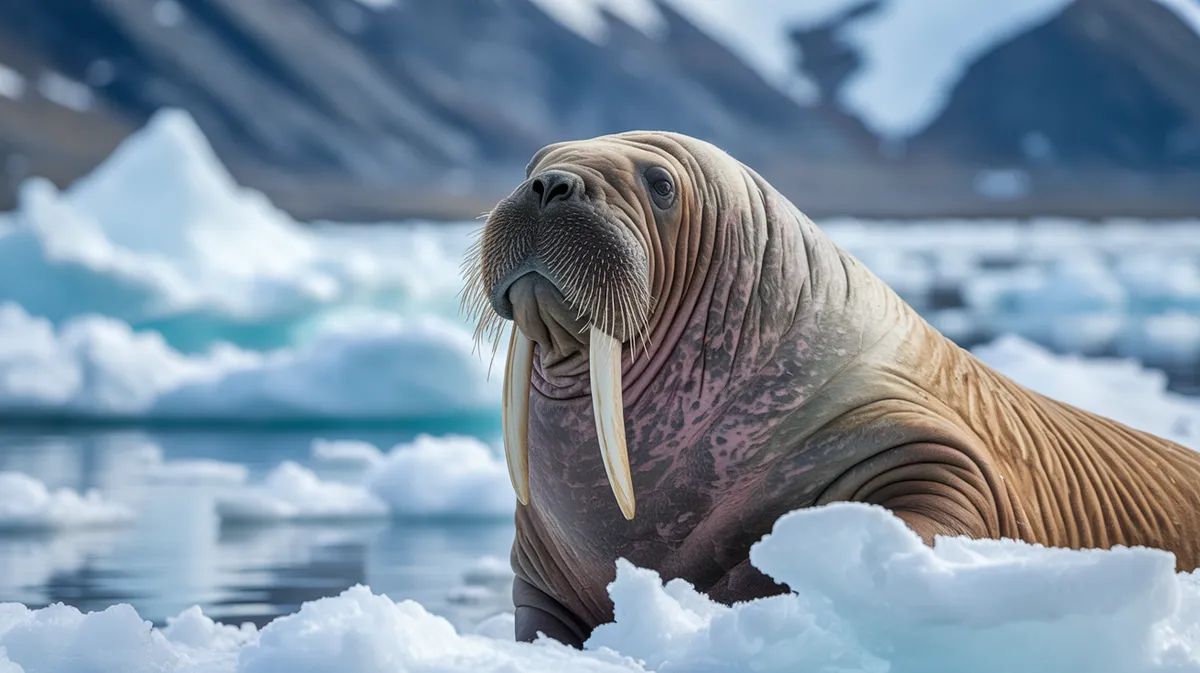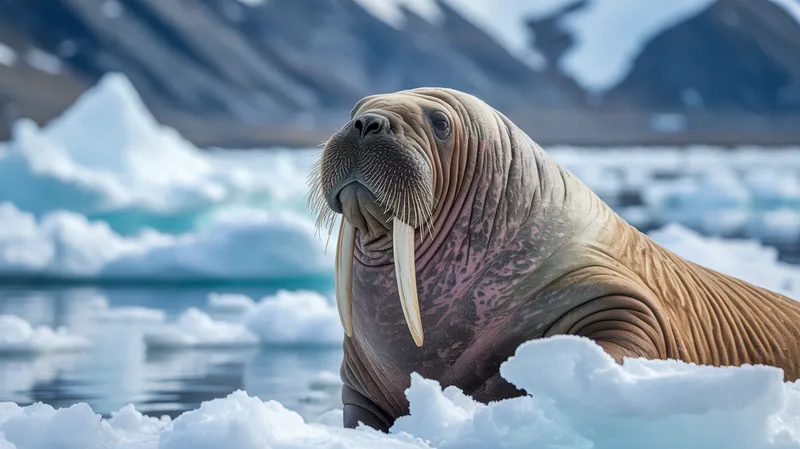
Walrus
Odobenus rosmarus

Meet the Walrus
The walrus is a large marine mammal known for its distinctive long tusks, whiskers, and massive, blubbery body. Found mainly in Arctic and sub-Arctic regions, walruses spend much of their time on sea ice and shallow coastal waters. They are highly social animals, often gathering in large herds and communicating through a range of vocalizations and physical gestures. Walruses are well adapted to their cold environment with thick skin and a heavy layer of blubber for insulation. Their tusks, present in both males and females, are used for defense, dominance displays, and hauling themselves out of the water onto ice.
Classification
Mammal
Habitat
Arctic and sub-Arctic coastal regions and sea ice
Diet
Carnivore
Lifespan
20-40 years
Conservation
Vulnerable
Weight
600-1,700 kg
📖Fascinating Facts
Enormous Tusks
Walrus tusks are used for breaking through ice, establishing social dominance, and helping the animals haul out of the water.
Benthic Feeders
Walruses use their powerful suction to extract soft-bodied prey, such as clams and snails, from the sea floor.
Arctic Dwellers
Walruses rely on sea ice for breeding, resting, and protection from predators like polar bears and killer whales.
📋Detailed Description
The walrus (Odobenus rosmarus) is a robust pinniped distinguished by its elongated tusks, vibrissae (whiskers), and thick, wrinkled skin overlaying a substantial blubber layer that can reach up to 15 cm in thickness. Adult males typically measure 3–3.6 meters in length and weigh between 800–1,700 kg, while females are slightly smaller, ranging from 2.3–3.1 meters and 400–1,250 kg. Both sexes possess tusks—enlarged canine teeth—that can grow up to 1 meter long and serve multiple functions, including social dominance, defense, and aiding in hauling out onto ice. The walrus's muzzle is covered in hundreds of sensitive vibrissae, which are crucial for detecting prey on the seafloor. Their skin varies from brown to pink, often appearing paler in cold water due to vasoconstriction. Walruses are highly gregarious, forming large aggregations on land or ice floes, sometimes numbering in the thousands. They are primarily benthic feeders, specializing in mollusks such as clams, but their diet can include worms, crustaceans, and occasionally fish or even young seals. Walruses exhibit seasonal migrations, following the retreat and advance of sea ice. Social structure is complex, with dominance hierarchies among males, especially during the breeding season. Reproduction is characterized by delayed implantation, with calves born after a gestation period of about 15–16 months. Calves are precocial, able to swim shortly after birth, and remain dependent on their mothers for up to two years.
💡 Did you know?
Despite their size and tusks, walruses mainly feed on small, soft-bodied invertebrates, especially clams and other mollusks.
🔬Research & Sources
Wikipedia Summary
The walrus is a large pinniped marine mammal with discontinuous distribution about the North Pole in the Arctic Ocean and subarctic seas of the Northern Hemisphere. It is the only extant species in the family Odobenidae and genus Odobenus. This species is subdivided into two subspecies: the Atlantic walrus, which lives in the Atlantic Ocean, and the Pacific walrus, which lives in the Pacific Ocean.
Last Modified: 5/23/2025
🎭Behavior & Social Structure
Walruses are predominantly social animals, often observed resting in dense groups on ice or land, where physical contact is frequent and vocalizations are common. Their daily activity patterns are influenced by tidal cycles, with feeding typically occurring during low tide when benthic prey is most accessible. Foraging dives can last from 5 to 30 minutes and reach depths of 80 meters, though most feeding occurs in shallower waters. Walruses use their sensitive vibrissae to detect and extract prey from sediment, employing suction feeding to remove soft tissues from shells. Social interactions are marked by a variety of vocalizations, including bell-like calls, grunts, and clicks, which play roles in maintaining group cohesion and establishing dominance. Males engage in ritualized displays and vocal competitions during the breeding season. Aggressive encounters, particularly among males, can involve tusk clashes and body posturing. Walruses also exhibit thermoregulatory behaviors, such as basking on ice or land to regulate body temperature.
👶Reproduction & Life Cycle
Walrus breeding occurs from January to March, with males establishing dominance hierarchies and competing for access to estrous females through displays and vocalizations. Copulation takes place in the water, after which females undergo delayed implantation; the fertilized egg remains dormant for 4–5 months before active gestation begins. The total gestation period is approximately 15–16 months. Calving typically occurs between April and June, with females giving birth to a single calf weighing 45–75 kg and measuring about 1.2 meters in length. Calves are born with a thin layer of blubber and are able to swim almost immediately. Maternal care is intensive, with calves nursing for at least one year and often remaining with the mother for up to two years. Females generally give birth every two to three years, reflecting the high energetic investment in each offspring.
🛡️Adaptations & Survival
Walruses possess several adaptations for Arctic survival. Their thick blubber provides insulation against frigid waters and serves as an energy reserve during periods of food scarcity. The large, flattened foreflippers and flexible hind flippers facilitate both aquatic propulsion and terrestrial locomotion. Tusks are multifunctional, aiding in mobility on ice, social interactions, and predator defense. The vibrissae are highly innervated, enabling precise detection of prey in low-visibility environments. Walruses can slow their heart rate (bradycardia) during dives to conserve oxygen and withstand cold temperatures. Their circulatory system allows for rapid adjustments in blood flow to the skin, aiding thermoregulation. Social behaviors, such as group haul-outs, also help reduce individual predation risk and conserve heat.
📚Research Sources
🎨Cultural Significance
Walruses hold profound significance for Indigenous Arctic peoples, including the Inuit, Chukchi, and Yupik, who have relied on them for millennia as sources of food, materials, and cultural identity. Walrus ivory has been traditionally carved into tools, art, and ceremonial objects. The animal features prominently in Arctic folklore, mythology, and oral traditions, often symbolizing strength, endurance, and the spirit of the sea. In Western culture, walruses have appeared in literature and popular media, such as Lewis Carroll's poem 'The Walrus and the Carpenter.' Conservation of walruses is closely tied to the preservation of Indigenous ways of life and Arctic heritage.
🔬Recent Research & Discoveries
Recent research has focused on the impacts of diminishing sea ice on walrus distribution, behavior, and reproductive success. Satellite telemetry and aerial surveys have improved understanding of migration patterns and habitat use. Studies on walrus vocalizations have revealed complex communication systems, particularly during breeding. Genetic analyses are clarifying subspecies distinctions and population structure, with ongoing debate about the status of the Laptev walrus. Emerging research is investigating the effects of ocean acidification and changing prey availability on walrus foraging ecology. Conservation efforts are increasingly integrating traditional ecological knowledge from Indigenous communities with scientific monitoring.
🎥Wildlife Videos

Walrus - 5 Minute Documentary
Embark on a thrilling Arctic adventure with a mesmerizing five-minute documentary that unveils the majestic world of the Walrus, ...
Five Minute Documentaries

Top 10 Walrus Facts | Animal Fun Facts | WWF
Did you know that walruses can change skin colour? Walruses are fascinating, highly sociable marine mammals found in tightly ...
WWF UK

Wally The Walrus | Short Wildlife Documentary
In this short documentary, Robi talks to us about Wally The Walrus, an Arctic walrus that has recently been spotted on UK shores ...
The Biome Project

What Do Walruses Eat? | Deep Dive into the Walrus Diet & Lifestyle
Dive into the Arctic Seas with us as we explore the fascinating diet of walruses in our latest video! "Arctic Giants Unveiled: What ...
Zooologist

Near Extinction - The Irony of the Walrus Hard Life
naturedocumentary #animaldocumentary #animals Discover the heartbreaking reality of walruses struggling to survive in their ...
Geo WILD Tube

Can They Survive? | The Story of the Walrus
Explore the life of the walrus in the Arctic, a resilient creature facing unprecedented challenges. As climate change melts the ice it ...
Nature Zone
🌍Habitat Information
The Walrus typically inhabits Arctic and sub-Arctic coastal regions and sea ice environments. Walruss have adapted to their environments with specialized features and behaviors.
Primary Habitat:
Arctic and sub-Arctic coastal regions and sea ice
More detailed habitat information will be available soon.
🛡️Conservation Status
The Walrus is currently classified as Vulnerable. Conservation efforts are crucial for preserving this species for future generations.
Common Threats:
- 🏠Habitat loss and fragmentation
- 🌡️Climate change impacts
- 🎯Hunting and poaching
- 🏭Human-wildlife conflict
⚠️Threats & Conservation Challenges
Major threats to walrus populations include climate change, which is rapidly reducing sea ice habitat critical for resting, breeding, and access to feeding grounds. Increased shipping, oil and gas exploration, and industrial development in the Arctic pose risks of disturbance, habitat degradation, and pollution. Walruses are also vulnerable to disease outbreaks and potential food web disruptions as ocean temperatures rise. Historically, walruses were heavily hunted for their ivory, blubber, and hides, leading to significant population declines, especially in the Atlantic subspecies. While commercial hunting has largely ceased, subsistence hunting by Indigenous peoples continues and is managed under international agreements. Population trends vary by region; the Pacific walrus population is estimated at several hundred thousand, though recent surveys indicate possible declines, while the Atlantic population remains much smaller and more fragmented.
🔬Scientific Classification
Scientific Name
Odobenus rosmarus
Classification Hierarchy
🔍 About Taxonomic Classification
Taxonomic classification is a hierarchical system used by scientists to classify and organize living organisms based on shared characteristics and evolutionary relationships.
The system moves from broad categories (Kingdom) to increasingly specific ones, with each animal's scientific name typically consisting of its Genus and species.
📝Community Notes
Share your observations and insights about the Walrus with our community of wildlife enthusiasts.
Join Our Community
Sign in to share your observations and connect with fellow wildlife enthusiasts.
Sign In to ContributeNo community notes yet
Be the first to share your observations about the Walrus!
Explore Walrus
Select a tab above to learn more about this amazing animal.
📸Photo Gallery
No photos available for this animal yet.
🌟Discover More Wildlife
Continue your journey of discovery with more fascinating animals from our database
